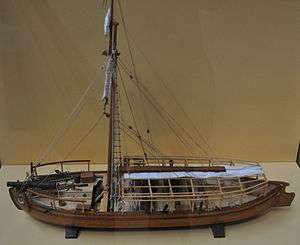Gundalow
A gundalow (also known in period accounts as a "gondola") is a type of flat-bottom sailing barge once common in Maine and New Hampshire rivers. They first appeared in the mid-1600s, reached maturity of design in the 1700 and 1800s, and lingered into the early 1900s before vanishing as commercial watercraft.[1] Up to 70 feet (21.34 m) long, they characteristically employed tidal currents for propulsion, with a single huge lateen sail brailed to a heavy yard to harness favorable winds.

Common cargoes were bricks, timber, cattle, sheep, and other bulk raw materials downriver, and finished goods up. Gundalows were very active delivering cordwood to brickworks to fire their kilns, picking up cargoes of finished bricks in return.
A form of sailing barge similar to a scow, gundalows were fitted with a pivoting leeboard in lieu of a fixed keel, giving them an exceptionally shallow draft and allowing them to "take the hard" (settle into sand, ledge, or mudflats) both for loading and unloading cargoes and maintenance. A gundalow's yard was attached to a stump mast and heavily counterweighted, pivoting down while still under sail to shoot under bridges while maintaining the boat's way.
Cannon-sporting gunboat style gundalows with fixed masts and square yards were built and deployed on Lake Champlain by both British and American forces during the American Revolutionary War, meeting in combat at the Battle of Valcour Island.
A replica gundalow, the Piscataqua, is maintained by a Portsmouth, New Hampshire non-profit and employed extensively in both grade school educational programs and raising environmental awareness among neighboring New Hampshire and Maine seacoast communities.[2] Its precursor, the Captain Edward Adams, built with traditional materials and methods in the 1980s, is preserved as a memorial in Dover, New Hampshire along the Cocheco River, one of the tidal headwaters of the Piscataqua River separating the states of Maine and New Hampshire.[3]
References
- What is a gundalow? gundalow.org
- "Gundalow Company". Gundalow Company. Retrieved 21 April 2018.
- New Dover playground officially opened, Seacoast Online
Bibliography
- Cross-Grained & Wiley Waters: A Guide to the Piscataqua Maritime Region, Jeffrey W. Bolster, Editor; Peter Randall Publisher, Portsmouth, 2001
- Ports of Piscataqua; soundings in the maritime history of the Portsmouth, N.H., Customs District from the days of Queen Elizabeth and the planting of Strawberry Banke to the times of Abraham Lincoln and the waning of the American clipper, William G. Saltonstall, New York, Russell & Russell [1968, c1941]
- The Piscataqua Gundalow: Workhorse for a Tidal Basin Empire, Richard E. Winslow, III, Portsmouth, NH, Peter Randall, Publisher (Portsmouth Marine Society) 2002
- The Way of the Ship: America’s Maritime History Reenvisioned, 1600-2000, Alex Roland, W. Jeffrey Bolster, Alexander Keyssar, Authors, Wiley, NY, 2007